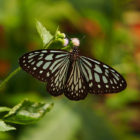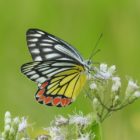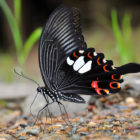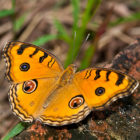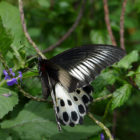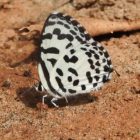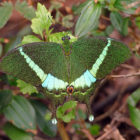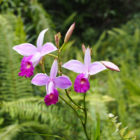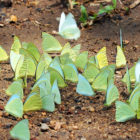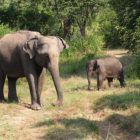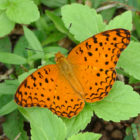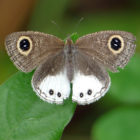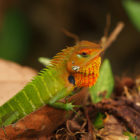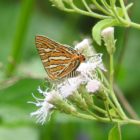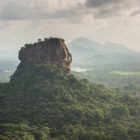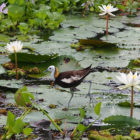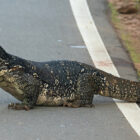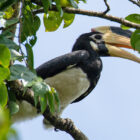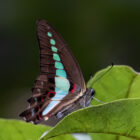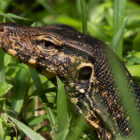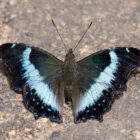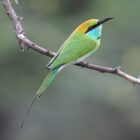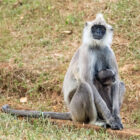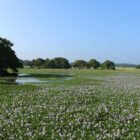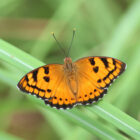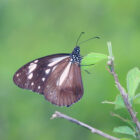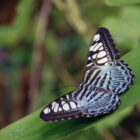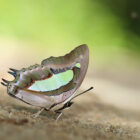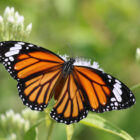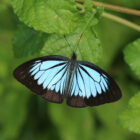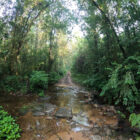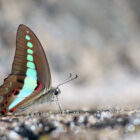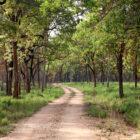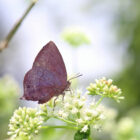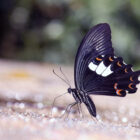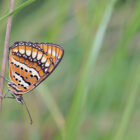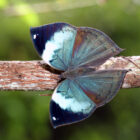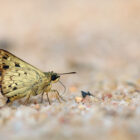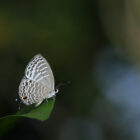Dates & Prices |
BOOK HOLIDAY NOW |
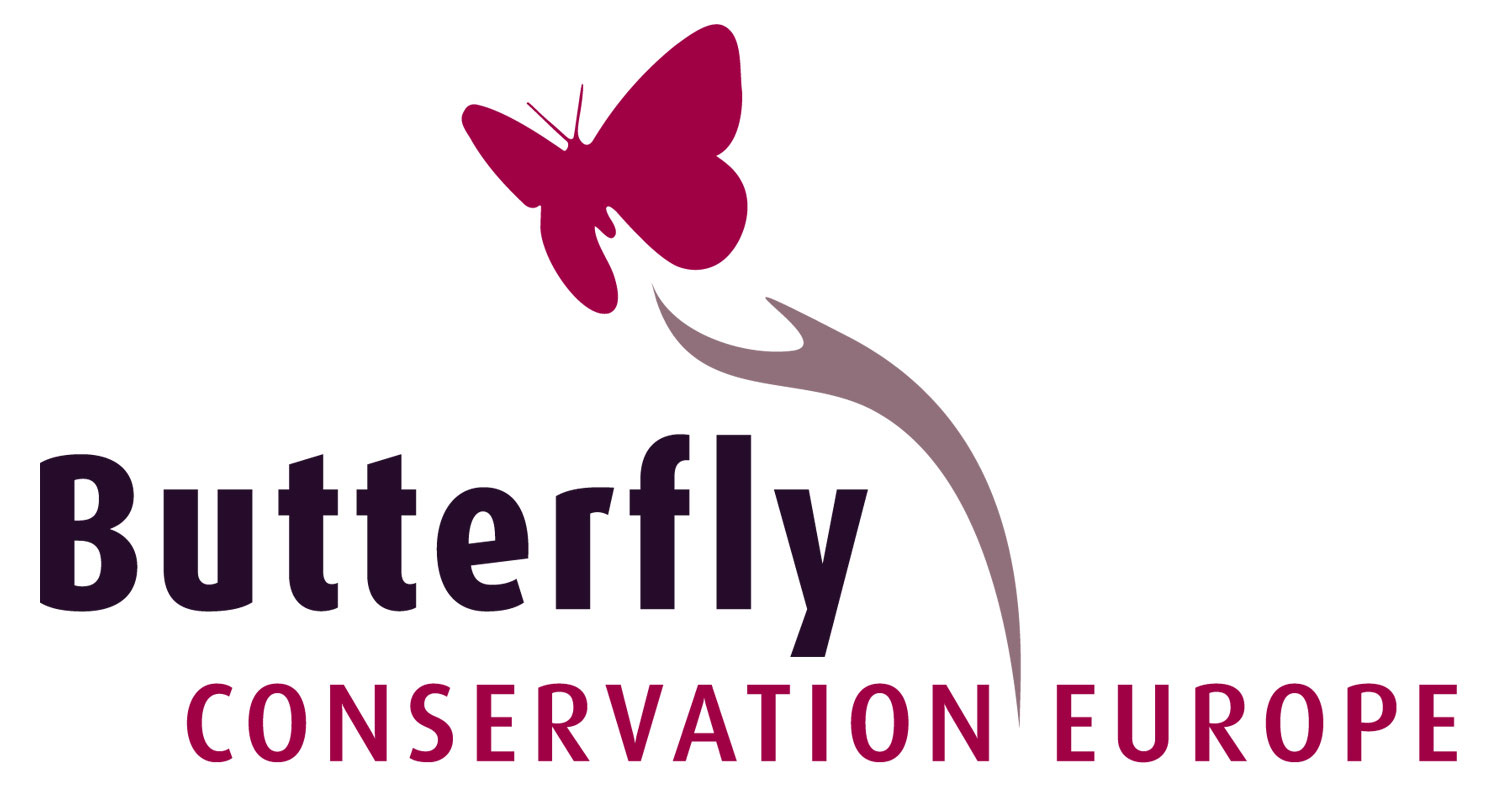 Dates: 23rd Feb – 8th March 2026
Dates: 23rd Feb – 8th March 2026
Price: £2,795 Places available
Single Room Supplement: £395
Deposit: £500 per person
Price Includes: All meals, accommodation with private facilities, ground transport, services of the guides, holiday report
Not Included: Flights, travel insurance, drinks and any other personal items
Conservation Donation: Butterfly Conservation Europe
Leader: Local guide + Greenwings guide for a larger group
Group Size: Minimum of 3 and a maximum of 8 guests plus 1-2 leaders
Grade: Gentle and slow pace
Holiday Highlights
- A gentle paced butterfly tour led by an expert Sri Lankan guide
- Sri Lanka has 248 butterfly species, including 31 endemics
- We can expect to see 140-155 species on the tour
- Special species such as Red Helen, Common Birdwing, Leopard, Banded Peacock, Tawny Rajah, Nawab, and a fine selection of Peacock, Yellow, Blue & Grey Pansies
- Endemics such as Sri Lanka Birdwing, Ceylon Rose, Lesser Albatross, Sri Lanka Tree Nymph & Sri Lanka Tiger
- Explore the best butterfly areas – Wasgamuwa National Park, Sinharaja Forest, misty mountains of Riverston, Ritigala Strict Natural Reserve etc
- Corbet’s Gap in Knuckles & Nilgala forest reserve will also give us a chance to see more rare & geographically restricted species
- Visit Kandy and the Temple of the Tooth plus the amazing ancient rock fortress of Sigiriya
- Lots of other wildlife, including numerous endemic birds & mammals
- Interesting flora too, including pretty Bamboo orchids along the trails & epiphytes adorning the trees
- In support of Butterfly Conservation Europe
A leisurely 2 week tour focusing on the butterflies of Sri Lanka
The tropical island paradise of Sri Lanka is astonishingly rich in wildlife and contains a wide variety of habitats ranging from misty highland forests and lush rainforest to arid, scrub-filled plains and an abundance of fresh water lakes. Over a tenth of the land mass is designated as protected areas for wildlife and the principal reserves are among the best in Asia. Although geographically close to India the zoology of the island displays many affinities to Indonesia and there is a marked degree of endemism, particularly in the remaining tracts of lowland forest to the south of the island where many of the birds, plants and insects are unique to Sri Lanka. Over 27 species of endemic birds is a high total for a country only a little more than a quarter the size of the United Kingdom, and the large number of endemic insects, plants, trees and reptiles is further evidence of the island’s long isolation from the mainland. 248 species of butterfly have been identified, 31 of these endemic to the island. As with the birds, the moist forests of the hill country and the south are home to some of the most interesting species but butterflies are a welcome sight throughout Sri Lanka and the aim of this tour is to visit some of the very best areas to observe them and identify the species encountered. In the course of our excursions we are sure to see a variety of other wildlife, particularly birds, but the focus will be very much on the butterflies in their myriad of colourful forms. Important note The intention of this tour is to observe and identify butterflies in the wild. The collecting of specimens is not permitted and is illegal in Sri Lanka. Any tour member discovered procuring butterfly specimens will be asked to immediately leave the tour and could be subject to prosecution in Sri Lanka. In principle we have no objection to the catching of insects for the purpose of identification as long as they are not harmed and released as quickly as possible but tour members should be aware that this practice is not allowed in any of the Protected Areas in Sri Lanka, nor is it permitted to take nets into these areas. Please do not consider travelling on this tour unless you are prepared to abide to these conditions.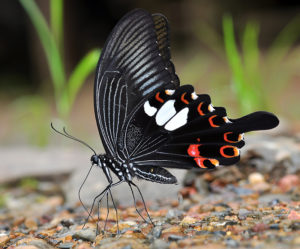

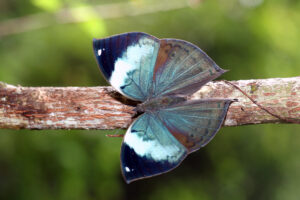
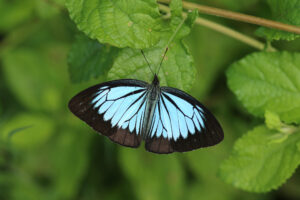
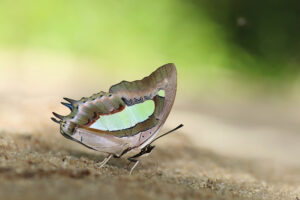
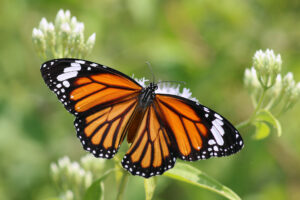
Please note that the itinerary below offers our planned programme of excursions. However, adverse weather & other local considerations can necessitate some re-ordering of the programme during the course of the tour, though this will always be done to maximize best use of the time and weather conditions available.
Day 0: International travel
Depart London in the evening on a direct Sri Lankan Airlines scheduled flight to Colombo. 20:40 departure time & arrival time of 12:30 the next day.
Day 01 – Colombo – Sigiriya
You will be met at the Hotel in Colombo in the morning by the Sri Lankan naturalist escort who will be with us throughout the tour. It is often said of Sri Lanka that anything placed in the ground will grow and as we travel out of the sprawl of Colombo into open country the evidence will be in the amazingly lush roadside vegetation. Palms, papayas, mangoes and all manner of exotic trees flourish in abundance and the overall impression of the countryside is of a tremendous greenness. En route we will stop at Anavilundawa Wetland Sanctuary, located in the northwestern part of Sri Lanka, is a unique ecosystem of freshwater marshes, lagoons, and paddy fields. This wetland is not only rich in birdlife, including migratory species, but it also supports a diverse range of butterflies, making it an excellent location for butterfly enthusiasts. Here are some butterflies you might encounter; Crimson rose, Common mormon, Lime butterfly, Tailed Jay, Plain tiger, Common tiger, Glassy tiger,
Blue tiger, Blue glassy tiger, Small salmon arab, Joker, Sri Lankan albatross, Common Pierrot, Common Sailor, Mottled Emigrant, Peacock Pansy
Birds that you may encounter; Lesser Whistling Duck, Cotton Pygmy Goose, Asian Open-bill, Black- headed Ibis, Eurasian Spoonbill, Indian Pond Heron and Purple Heron, plus Eastern Cattle, Great, Intermediate and Little Egrets, Spot-billed Pelican, Little, Indian, and Great Cormorants, Oriental Darter, Brahminy Kite, White-breasted Waterhen, Grey-headed Swamp hen, Common Coot, Pheasant-tailed Jacana, Red-wattled Lapwing, Whiskered Tern, Rose-ringed Parakeet, Indian Swiftlet, Asian Palm Swift, House Crow, Barn Swallow, White-bellied Drongo and Yellow-billed Babbler. We will have lunch en-route and then proceed to Sigiriya. If time permits, birding around the hotel.
Overnight Stay at Hotel Sigiriya
Day 02 –Sigiriya
In the morning, after breakfast we will travel to the Ritigala Strict Natural Reserve for a full day excursion with pack lunch. This rocky outcrop, emerging like Sigiriya from the dry lowlands, exhibits several distinct types of forest vegetation becoming progressively moist with increases in elevation until the forest around the summit resembles that of the hill country. There is a very ancient archaeological site within the forest, which we can visit during our afternoon exploration. A splendid variety of butterflies includes many of the insects seen during preceding days such as the Blue Mormon and Chocolate Soldier but we will also be hoping for a number of additions with possibilities including; Spot Swordtail (Pathysa nomius), Great Orange-Tip (Hebomoia glaucippe), Lace Wing (Cethosia nietneri) and the Nawab (Polyura athamas), Black Rajah (Charaxes solon), Dark-brand Bushbrown (Mycalesis mineus), Purple Leaf Blue (Amblypodia anita), Common Cerulean
(Jamides celeno), Pea Blue (Lampides boeticus), Zebra Blue (Leptotes plinius), Common Pierrot (Castalius rosimon), Lime Butterfly (Papilio demoleus), Mime (Chilasi clytia), Common Jay (Graphium doson), Dark Wanderer (Pareronia ceylanica), Tawny Rajah (Charaxes psaphon), Psyche (Leptosia nina), Glassy Tiger (Danaus aglea), Blue Tiger (Tirumala limniace), Dark Blue Tiger (Tirumala septentrionis), Common Crow (Euploea core), Double Branded Crow (Euploea sylvester), Common Sailor (Neptis hylas), Gladeye Bushbrown (Nissanga patnia), White Four-ring (Ypthima ceylonica) and Common Palmfly (Elymnias hypermnestra).
After an exciting full day with butterflies, you can enjoy dinner at the hotel, perhaps sampling some local Sri Lankan cuisine, and then rest up for the next day’s adventures. Whether you’re unwinding by the pool or simply enjoying the serene surroundings, it’s the perfect spot to relax and recharge for another day of exploration
Overnight Stay at Hotel Sigiriya
Day 03 –Sigiriya – Knuckles
Today’s morning objective is the Kaludiya Pokuna Forest Reserve which is situated close to Sigiriya. This is also a rock outcrop like Ritigala but is not so high and the low country Dry Zone surroundings ensure another range of butterfly possibilities. Among the species recorded from here are; Lime Butterfly (Papilio demoleus), Mime (Chilasi clytia), Common Jay (Graphium doson), Dark Wanderer (Pareronia ceylanica), Tawny Rajah (Charaxes psaphon), Psyche (Leptosia nina), Glassy Tiger (Danaus aglea), Blue Tiger (Tirumala limniace), Dark Blue Tiger (Tirumala septentrionis), Common Crow (Euploea core), Double Branded Crow (Euploea sylvester), Common Sailor (Neptis hylas), Gladeye Bushbrown (Nissanga patnia), White Four-ring (Ypthima ceylonica) and Common Palmfly (Elymnias hypermnestra), White Banded Awl (Hasora taminatus).
Lunch en-route to Knuckles mountain range where we will spend the day driving through the mountains exploring the area for butterflies. It is elevated approximately 850 metres above the sea level and is located 30 kilometres from the Matale town, rather windy with quite a few hairpins turns but in good condition, offers great views all around.
‘Dumbara’ the mist laden mountains, is the Sinhalese name for these mountains which derive their English name from the clenched fist appearance of the ridges. This is a wild expanse of undulating hills, misty forests, pastures and forests rich in flora and fauna. Two endemic creatures found here are the Tennent’s Horned Lizard and Keerthisinghe’s Rock Frog plus a tremendous variety of birdlife. Species we particularly hope to see at Riverston include Common Birdwing (Troides darsius), Banded Peacock (Papilio crino), Red Helen (P. helenus), Common Bluebottle (Graphium sarpedon), Tree Nymph (Idea iasonia), Ceylon Tiger (Parantica taprobana) and Common Tree Brown (Lethe rohria)
Overnight stay at Grand Mountain Hotel – Matale
Day 04 –Knuckles Mountain Range – Riverstone
In the early morning, we will leave again for the misty mountains of Riverston with picnic lunch and will spend the whole day exploring this area.
The Riverston area shelters a number of endemic plants and animals. Bushy plants with mild streams running across make this valley an ideal habitat for the butterflies. The mist clad scenic Riverston peak via pittawala pathana, offers some of the greatest views of the central hills across the mini worlds end which ends in a sheer drop of 300 meters offering a great vista especially of the ‘Knuckles range’, and the Thelgamu valley below with its terraced paddy field method unique to the central hills of Sri Lanka. Pitawala Patana offers excellent habitats for more hill country butterflies. In addition to species already mentioned, insects in this area could include: Banded Peacock (Papilio crino), Painted Sawtooth (Prioneris sita), Common Albatross (Appias albina),Sri Lankan Lesser Albatross (Appias galene) Indian Fritillary (Argynnis hyperbius), Great Eggfly (Hypolimnas bolina), Ceylon Forester (Lethe dynaste), Red Pierrot (Talicada nyseus), Common Silverline (Spindasis vulcanus), Plumbeous Silverline (Spindasis schistacea), Great Orange Tip (Hebomoia glaucippe), Sri Lankan Tiger (Parantic taprobana), Beak (Libythea Laius), Tamil Treebrown (Lethe drypetis), Monkey-puzzle (Rathinda amor), Tropic Dart (Potanthus confuscius).
Overnight stay at Hotel Grand Mountain – Matale
Day 05 – Knuckles Mountain Range – Corbett’s Gap
After breakfast we will proceed to Kandy which will provide further views of the island life as we pass through little market towns where the produce for sale will be displayed in a colourful mixture of roadside stalls. Heaps of tempting looking fruit will be further evidence of the island fecundity and the taste of local grown fruit such as pineapple is infinitely superior to any you can obtain in Britain. The city of Kandy is steeped in history and was the capital for a succession of Kandyan Kings until captured by the British in 1815. The famous ‘Temple of the Tooth’ beside Kandy lake is one of the
best known Buddhist temples in the country and attracts thousands of visitors every year. We will visit the Temple of the Tooth and lunch afterwards at a restaurant in Kandy.
Afternoon we will arrive to Rangala and butterfly watching around the hotel if time permits.
Overnight stay at a hotel in Rangala
Day 06 & 07 – Knuckles Mountain Range – Corbett’s Gap
Corbett’s Gap. It is one of the highest mountain passes in Sri Lanka named after British Army Colonel, naturalist and adventurer, Jim Corbett. The hike is mostly along an abandoned jeep track that cuts through the Knuckles Conservation Forest, a designated UNESCO World Heritage Site. These montane cloud forests, where the land rises to 3000 ft above sea level, are home to an extraordinary range of flora and fauna, including several butterfly species such as Small Leopard (Phalanta alcippe), Rare Ace (Halpe egena), Blank Swift (Caltoris kumara), Tamil Lacewing Butterfly (Cethosia nietneri), Painted Sawtooth (Prioneris sita), Great Orange Tip (Hebomoia glaucippe), Common Beak (Libythea lepita), Ceylon tiger (Parantica taprobana), Tiny Grass Blue (Zizula hylax), Common Hedge Blue (Acytolepis puspa), Redspot Duke (Dophla evelina), Indian Fritillary (Argynnis hyperbius), Glad-eye Bushbrown (Mycalesis patina), Common Castor Butterfly (Ariadne merione)
Overnight stay at a hotel in Rangala
Day 08 & 09 – Bibile & Nilgala Forest reserve
After breakfast we will drive to our next destination Bibile which is located in the South East of the country and Nilgala Forest Reserve, located near Bibile, is a stunning and ecologically significant forest. It is part of the Gal Oya National Park and is known for its unique mix of savanna grasslands, dry zone forests, and medicinal plant diversity. Historically, this area was a royal hunting ground for ancient Sinhalese kings. We will be spending two nights at this unique location and our main target butterflies will be, Spotless Grass Yellow (Eurema laeta),Baronet (Symphaedra nais), Plumbeous Silverlines (Spindasis schistacea), Tawny Rajah (Charaxes psaphon), Dingy Lineblue (Petrelaea dana), Common Rose (Pachliopta aristolochiae), Blue Mormon (Papilio polymnestor), Tamil Yeoman (Cirrochroa thais), Chestnut Streaked Sailor (Neptis jumbah), Hampson’s Hedge Blue (Acytolepis lilacea), and Golden Angle (Caprona ransonnettii), Blue Pansy female (Junonia orithya), Large Oakblue (Arhopala amantes) and Sri Lankan Jewel Four-ring (Ypthima singala), Sri Lankan Tamil Bush Brown (Mycalesis subdita) which are endemic to our country.
Other than the butterflies, Nilgala forest reserve is also boats to some of the special birds that occurs only in the Savanna habitat. Painted francolin, Yellow-footed green pigeon, Jungle-owlet, Jungle bush-quail, Square-tailed drongo cuckoo, Banded-bay cuckoo can be sighted.
Overnight stay at Kinkini Hotel, Bibile (Basic accommodation)
Days 10 & 11 – Udawalawe
Today offers a striking change of pace as you explore Uda Walawe National Park by jeep, trading the forest birdwatching of the past days for a day spent in the Dry Zone’s open habitats. This park, which includes a mixture of teak plantations, grasslands, scrub jungle, and wetlands, is ideal for spotting a variety of birds and animals that are found in the island’s arid, lowland regions—habitats not covered earlier in the tour.
During the morning drive, you’ll encounter a range of species that are restricted to the Dry Zone. Expect to add a number of exciting species to your list, including Sri Lanka Junglefowl, Plum-headed Parakeet, Barred Button-Quail, Changeable Hawk-Eagle, White-bellied Sea-Eagle, Gray-headed Fish-Eagle, and Brown Fish Owl. The park is also home to the Malabar Pied Hornbill, as well as the elusive Sirkeer and Blue-faced Malkohas. Smaller species, like Black-headed and White-throated Munias, White-tailed and Common Ioras, Brown-capped Pygmy Woodpecker, Rufous Woodpecker, and Sri Lanka Woodshrike, can also be found in the park’s diverse habitats.
In addition to birds, Uda Walawe is famous for its elephant population. The park is home to several hundred Sri Lanka Asian Elephants, and on an average visit, you can expect to see 40-50 individuals. Close encounters with nursery herds escorting young calves are truly unforgettable moments that add to the magic of the experience.
Overnight stays at a Centuria Wild – Udawalawe
Day 12 – Sinharaja Rain forest
One of the highlights of our tour will be an excursion into Sinharaja Forest, the largest and most significant lowland rainforest in Sri Lanka. Recognized as a UNESCO World Heritage Site in 1988, Sinharaja serves as a sanctuary for many endemic birds, making it a paradise for bird enthusiasts.
We will explore the forest along old logging trails that provide access to its untouched beauty. These trails offer the chance to spot an incredible variety of bird species, including Legge’s Hawk-Eagle, Crested Goshawk, Sri Lanka Spur-fowl, Layard’s Parakeet, Sri Lanka Hanging Parrot, Red-faced Malkoha, Green-billed Coucal, Malabar Trogon, Sri Lanka Frogmouth, Brown-backed Needletail, and Chestnut-backed Owlet. Other highlights may include the Yellow-fronted Barbet, Black-capped, Square-tailed, and Yellow-browed Bulbuls, Sri Lanka (Crested) Drongo, Sri Lanka Scimitar-Babbler, Spot-winged Thrush, Sri Lanka (Scaly) Thrush, Orange-billed Babbler, Ashy-headed Laughing thrush, Sri Lanka Blue Magpie, White-faced Starling, Southern Hill Myna, Sri Lanka Myna, White-throated Flowerpecker, and Black-throated Munia.
Potential list of butterfly species are the black and yellow Sri Lanka Birdwing (Troides darsius) and the equally impressive Red Helen (Papilio helenus) but there are many jewels to look for in this very special forest including; Common Mormon (Papilio polytes), Blue Mormon (P.polymnestor), Sri Lankan Rose (Pachliopta jophon), Common Bluebottle (Graphium sarpedon), Psyche (Leptosia nina), Common Jezebel (Delias eucharis), Sri Lankan Tree Nymph (Idea iasonia), Common Leopard (Phalanta phalantha), Commander (Moduza procris), Clipper (Parthenos sylvia) and Tailed Jay (Graphium agamemnon), Great Crow (Euploea phaenareta), Sri Lankan Blue Oak Leaf (Kallima philarchus), Club Beak (Libythea myrrha), Gladeye Bushbrown (Mycalesis patnia), Sri Lankan Cerulean (Jamides coruscans), Restricted Demon (Notocrypta curvifascia).
While it’s unlikely to see all these species in a single visit, Sinharaja is a magical place where periods of quiet can quickly give way to vibrant activity. Even at midday, you might encounter one of the forest’s famed mixed-species “bird waves.” These often include Orange-billed Babblers, Ashy-headed Laughing thrushes, Crested Drongos, Malabar Trogons, Red-faced Malkohas, and Blue Magpies, among others.
Sinharaja’s charm extends beyond its birds. The forest’s flora includes numerous endemic species, with trails lined by the delicate Bamboo Orchids and trees adorned with epiphytes. Its butterfly
population is equally impressive, featuring the spectacular Blue Mormon and the ethereal Tree Nymphs, which flutter through the canopy like drifting paper.
Reptile enthusiasts will find a wealth of lizards, including rare endemic species. Mammal sightings, though unpredictable, can be equally rewarding. Troupes of Purple-faced Leaf Monkeys often announce their presence with the resonant, roaring calls of their males, adding an extra layer of enchantment to this biodiverse haven.
Overnight stay at Blue Magpie Lodge – Sinharaja
Day 13 – Sinharaja – Colombo
Today, we return to Katunayake, but before we depart from the Blue Magpie, we’ll spend one last morning birding and butterfly watching in the hotel’s vicinity. The early hours often reveal Green-billed Coucals, which are relatively easy to spot at first light. Other intriguing residents in the area include the Spot-winged Thrush, Chestnut-backed Owlet, Oriental Dwarf Kingfisher, and Black-throated Munia.
Eventually, we will have to bid farewell and embark on a three-hour drive north along the southern highway. Upon arriving in Katunayake, we’ll check into Tamarind Tree Hotel to enjoy some well-deserved rest and a comfortable night’s sleep.
Overnight stay at Colombo
Day 14 Departure
We have a morning transfer to Katunayake airport to catch our flight to London or other international destination.
Ralph and Claudette M, 2023: Thank you so much for the fantastic Greenwings Sri Lanka trip you put together for us on such short notice. Everything went incredibly well and we thoroughly enjoyed ourselves the entire time.
The accommodations were excellent throughout the trip. The food was amazing—we were able to try so many delicious new foods all along the way. And the King Coconuts were just what we needed on the hot days! Our driver, Jayaweera, was exceptional and his ability to navigate narrow roads made us feel very safe the entire time.
And, of course, the butterflying was superb. Everything we saw was new to us, so having an expert guide to show us the Sri Lankan butterflies was tremendous.
Which gets to our main reason for writing. Dhanushka was our guide for the 2 weeks and we could not have had a better person with whom to share those 2 weeks. He is so knowledgeable (how you can tell the smallest of blues and skippers with only a glance or a quick look through binoculars is far beyond our skill level!) and conscientious. We were very impressed that he sincerely wanted us to learn as much as possible about butterflies so that we could also identify them in the field. He pointed out subtle differences among species, then when it was hard for us to discern those differences, we looked at our photos in the evening and went over the distinguishing characteristics of similar-looking butterflies. The Lineblues and Skippers in particular were challenging for us, but Dhanushka brought a detailed reference book and worked through the details for us to be able to separate those species (which we never could have done on our own since there is considerable variation within a species, and also differences in wet season/dry season forms).
His enthusiasm for Sri Lanka and in particular its natural history made it a very educational trip for us. He pointed out birds, mammals, reptiles, and plants, and told us so much about life in Sri Lanka. In short, he gave so much of himself, and because of that, we have never had such an incredible rewarding experience. It was so intimate to be in such a small group.
I hope future Greenwings trips will be able to go with Dhanushka. He has a great sense of humour, is someone we both immediately felt very comfortable being with, and his enthusiasm for what he does is contagious. We wish the trip could have gone on longer…..
Well, Matt, once again Greenwings has provided us a fantastic trip, and we’ll have to see if we can join up with another one down the road. You always provide such outstanding experiences. This one, though, will always be special for us because of the time we shared with Dhanushka who showed us such beautiful places and was so open and generous to us.
Thank you so much.
Ralph and Claudette
Allan F 2019: I felt that this was an outstanding trip, made particularly so by Indika’s expert knowledge of the butterflies and birds, his quick eye for spotting things and his friendly and easy going manner. The accommodation throughout was fine, with Thilanka Hotel Levendish Wild and Sigiriya Hotel being exceptionally comfortable. Blue Magpie Lodge and Sir John’s Bungalow were a little more basic but both were more than compensated for by their locations. Sir John’s Bungalow, in particular, commanding spectacular views of the Knuckles range and being close to the butterfly sites, cutting down on travelling time. Being there felt like being a guest in a private home rather than a hotel as it was so cosy and welcoming. Overall the food was fine and plentiful with plenty of choice of both Western and local dishes, the only problem being I will now have to loose a few kilos!


